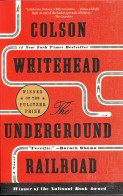

An act of violence changes her mind, though, and she flees with a newly-brought slave named Caesar. She’s since been singled out on the farm as a potential troublemaker and thinks that escape would not be worth the risk. Cora’s mother, Mabel, fled the farm, seemingly escaping to freedom and abandoning her daughter, something for which Cora has never forgiven her. “When you are sold that many times, the world is teaching you to pay attention.” She eventually died on the Randall family’s farm, clinging to a small plot of land. Her grandmother was the first enslaved in her family and sold and resold several times. He essentially remixes the story of slavery and escape through a sort of Twilight Zone parabolic logic that never diminishes the viciousness and lunacy of the institution, but brings it into starker relief in the foreground.Ĭora is a young slave who is reluctant to run, but almost destined to escape. A society that condones torture, in other words, eventually becomes a society that is held together only through torture.Įven now, it’s exceedingly difficult to make art or write fiction about America’s “original sin.” If the violence is too much in the foreground, the story can become a numbing litany of brutality and yet, play too much into the audience’s desire for payback or comic relief, and you can wind up with a glib, adolescent power fantasy à la Django Unchained. What Whitehead does in The Underground Railroad is, therefore, really quite extraordinary. But, of course, what was much worse about slavery was how the loss of liberty and the underlying system of violence intertwined and reinforced one another. Mythologists have sometimes liked to imagine American slavery to be something akin to indentured servitude, or even adoption into a wealthy family. I remember little about the assignment, but I do recall being struck by two things: there were a great number of runaway slaves (little surprise really) and many of the slaves listed could be distinguished by disfiguring scars and wounds, or missing appendages. These are the sort of ads that Colson Whitehead mimics throughout his novel The Underground Railroad, the latest book I have retrieved from the Little Free Library across the street.

About a quarter-century ago, when I was an unwashed undergraduate studying history in the faux-historical town of Williamsburg, Virginia, I completed an assignment for a primary research course in which I studied runaway slave postings from colonial era newspapers.


 0 kommentar(er)
0 kommentar(er)
